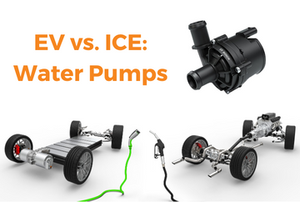EV vs. ICE: How to Utilize Automotive Water Pumps
Featured Product from Chief Enterprises LLC

EV vs. ICE: How to Utilize Automotive Water Pumps
When it comes to designing an efficient vehicle, many components work together to ensure optimal performance. One of these critical components is the automotive water pump. While it may seem inconspicuous, its role is vital in maintaining the engine and EV battery system’s temperature and overall health. Below you will discover what water pumps do in combustion engine (ICE) vehicles and in electric vehicles (EV) and why they are essential to a vehicle's functionality.
What is an Automotive Water Pump and What Do They Do?
An automotive water pump is a small but powerful device that circulates coolant, (usually a mixture of water and antifreeze) throughout the engine and radiator. Its primary purpose is to regulate and control the engine's temperature, ensuring it doesn't overheat during operation. Other applications within an ICE system include heater circuit, auxiliary heater, charge-air cooling, generator cooling, turbocharger cooling, and fuel cooling.
In an electric vehicle, the role of the water pump differs from that in ICE vehicles. In an EV, there is no internal combustion engine to cool, but there are still critical components that require temperature regulation. In an electric vehicle the water pump does three primary functions:
- Battery Cooling: The main purpose of the water pump in an EV is to cool the high-voltage battery pack. EVs rely on large lithium-ion batteries to store and deliver electrical energy. These batteries generate heat during charging and discharging cycles, as well as during fast charging or heavy use. Excessive heat can reduce the efficiency and lifespan of the battery and even pose safety risks.
- Temperature Management: In addition to cooling the battery the water pump also helps to maintain the battery’s temperature. If the battery gets too hot, it can lead to performance issues and reduce the vehicle's driving range. On the other hand, if the battery gets too cold, its efficiency may decrease, affecting both range and charging speed.
- Climate Control: The water pump is also involved in regulating the temperature of the EV cabin. Electric vehicles often use a heat pump or electric resistance heaters to provide heating and cooling for passengers. The water pump may circulate a coolant through these systems to manage the cabin temperature.





